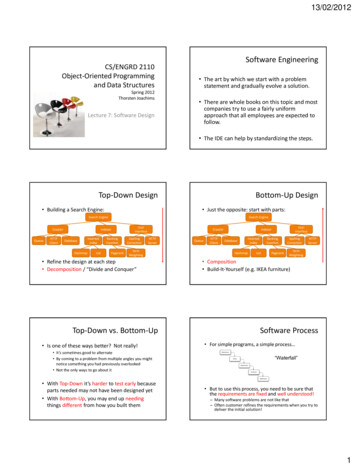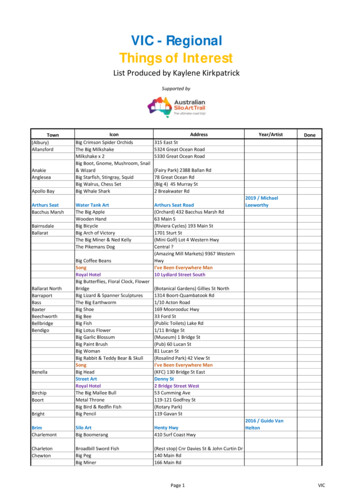
Transcription
Big O & ArrayList15-121 Fall 2020Margaret Reid-Miller
Today Office Hours: Thursday afternoon (time to beannounce on Piazza) Big O Amortized runtime ArrayListsFall 202015-121 (Reid-Miller)2
How do we determine howefficient (fast) and algorithm is?Key Idea:The running time of an algorithm depends onthe size of the problem it's solving.Fall 202015-121 (Reid-Miller)3
Big O: Formal Definition Let T(n) – the number of operations performed in analgorithm as a function of n. T(n) O(f(n)) if and only if there exists two constants,n0 0 and c 0 and a function f(n) such that for alln n0, cf(n) T(n).Fall 202015-121 (Reid-Miller)4
How long does it take to- say "California" and then- fly to CaliforniaThe time to fly to California (roughly 6 hours)dominates the time to say "California", so weignore the time to say "California".Fall 202015-121 (Reid-Miller)5
Big-O notationLet n be the size of the problem (input):Time(n) 4n 9 O(n)Time(n) 2n2 – 4n 1 O(n2)Time(n) log3(n) O(log n)Time(n) 3n O(3n), not O(2n)!There is no c that satisfies c.2n 3n forarbitrarily large n.Fall 202015-121 (Reid-Miller)6
More on Big O Big O gives us an upper-bound approximation on thecomplexity of a computation. That is, think of Big O as “ ” n 1000 is O(n), but it’s also O(n2) and O(n3). Wetry to keep the bound as tight as possible, though,so we say n 1000 is O(n).Fall 202015-121 (Reid-Miller)9
Big-O when algorithm is A then B Suppose an algorithm is doA followed by B. Then the overall complexity of the algorithm ismax (O(A), O(B)).Examples:O(log n) O(n) O(n)O(n log n) O(n) O(n log n)O(n log n) O(n2) O(n2)O(2n) O(n2) O(2n)Fall 202015-121 (Reid-Miller)11
Big-O when algorithm is Aencloses B E.g., Nested loops: A is the outer loop B is the innerloop, or A calls B repeatedly Then the overall complexity of the algorithm isO(A) * O(B),where O(A) excludes the complexity of B.Examples:O(n) * O(log n) O(n log n)O(n log n) * O(n) O(n2 log n)O(n) * O(1) O(n)Fall 202015-121 (Reid-Miller)12
How do we grow the contacts arraywhen it is full?We create a new array that is larger than the contactsarray and copy all the elements to the new array.Sometimes, the cost to add a single Person is O(1)because there is room in contacts.But sometime the cost to add a single person is O(n),n numContacts, because we need to expand thearray and copy n elements.What is the worst case runtime for callingadd(name, number) n times, when we start with anarray of length 1?Fall 202015-121 (Reid-Miller)13
Number of copies to grow an array to lengthn starting with an array of length 1.Grow by 1 each time:The array is full when1, 2, 3, 4, 5, 6, elements in the arrayAfter adding n elements we copied1 2 3 4 (n-1) n(n-1)/2 O(n2) elementsGrow by 100 each time:The array is full when100, 200, 300, 400, 500, elements in the arrayAfter we have added n 100*k elements we copied100 200 300 100(k-1) elements 100k (k-1)/2Growing by a n (n/100 – 1)/2 O(n2 )constantdoes O(n2) copiesFall 202015-121 (Reid-Miller)14
By doubling the array length, adding nelements does O(n) copies.The array is full when we have1, 2, 4, 8, 16, 32, elementsAfter we have added 32 elements we copy1 2 4 8 16 31 elements to a larger arrayAfter we have added 64 elements we copy1 2 4 8 16 32 63 elements to a larger arrayAfter adding n elements,we have copied a total of O(n) elements to a larger array!Fall 202015-121 (Reid-Miller)15
What is the worst-case run time foradding n Persons to a ContactList?Therefore, the worst-case runtime for n calls toadd() is O(n).We, therefore, say that the amortized worst-caseruntime for a single call to add() is O(1).Definition: Amortized worst-case runtime is theexpected runtime per operation of a worst-casesequence of n operations.(This is not the same as Average runtime, whichis runtime of a single operation averaged overall distinct inputs.)Fall 202015-121 (Reid-Miller)16
ArrayListsFall 202015-121 (Reid-Miller)17
Abstract Data Types vsData Structures Abstract Data Type: An ADT is a formal description ofthe behavior (semantics) of a type.1. The representation/organization of the data ishidden.2. Specifies the operations that can be applied to theunderlying data independent of any particularimplementation. (Defines the interface of the ADT.) Data Structure: A data structure is a concreterepresentation/organization of data and algorithms in aspecific implementation of a ADT.Fall 202015-121 (Reid-Miller)18
The ArrayList Class For Java folks, an ArrayList is like an array, but: It’s a class, so we construct it and call methods on it. It’s resizable. It grows as we add elements and shrinksas we remove them. For Python folks, an ArrayList is like a Python list, but: We do not use subscript notation. ArrayLists (like arrays) are homogeneous.ArrayList String names new ArrayList String ();Fall 202015-121 (Reid-Miller)19
java.util.ArrayList E ArrayList methodsboolean add(E obj)Appends obj to end of this list; returns truevoid add(int index, E obj)(0 index size)Inserts obj at position indexvoid clear()Removes all the elements from this list.boolean contains(Object obj)Returns true if this list contains obj.E get(int index)Returns the element at position index (0 index size)int indexOf(Object obj)Returns the index of the first occurrence of obj in this list,or returns -1 if this list does not contain objFall 202015-121 (Reid-Miller)20
java.util.ArrayList E ArrayList methodsboolean isEmpty()Returns true if the list is empty and false otherwiseE remove(int index)(0 index size)Removes element at position index;Returns the element formerly at position index.boolean remove(Object obj)Removes the first occurrence of obj, if present;Returns true if this list contained obj, false otherwise.E set(int index, E obj)(0 index size)Replaces element at position index with obj;Returns the element formerly at position index.int size()Returns the number of elements in the list.Fall 202015-121 (Reid-Miller)21
ArrayList complexityWorst Bestint size()add(E obj)add(int index, E obj)get(int index)set(int index, E obj)O(1)O(1)*contains(Object obj)remove(int index)remove(Object obj)indexOf(Object ll 2020O(n)O(1)O(1)*O(1)O(1)O(1)15-121 (Reid-Miller)*amortized22
ArrayList demoimport java.util.ArrayList;ArrayList String names new ArrayList String ();names.add(“Margaret”);// Margaretnames.add(“Dave”);// Margaret Davenames.get(1);// returns Davenames.set(0, “Mark”);// Mark Davenames.add(1, “Tom”);// Mark Tom Davenames.remove(1);// Mark DaveFall 202015-121 (Reid-Miller)23
Wrapper Classes ArrayLists can only store references to objects, notprimitive values. All primitive types have a corresponding object type(wrapper class). Example: Integer, Double, Boolean, Integer x new Integer(62);Integer y new Integer(“12”);int n y.intValue();Fall 202015-121 (Reid-Miller)24
ArrayLists with IntegerArrayList Integer intList new ArrayList Integer ();intList.add(new Integer(3));int n intList.get(0).intValue();YUCK!Fall 202015-121 (Reid-Miller)25
Java does conversion betweenprimitive and wrapper typesArrayList Integer intList new ArrayList Integer ();intList.add(3);// converts int to Integerint n intList.get(0); // converts Integer to int Like mixing primitive types, based on the types of literals,parameters and variables, Java converts between primitiveand wrapper types.Fall 202015-121 (Reid-Miller)26
Auto-boxingInteger a i ;// auto-boxingInteger b j 2;int k a b;// auto-unboxingSystem.out.println(a.toString() b.toString()); // concatSystem.out.println(a b);// unboxed addWarning:if (list.get(0) list.get(1))Does not auto-unbox! It compares the references to Integerobjects.Fall 202015-121 (Reid-Miller)27
Example: count// Returns the number of names in the given list// with the given number of letterspublic static int count( ArrayList String names,int numLetters) {int count 0;names.size() ; i ) {for (int i 0; i if (names.get(i).length() numLetters) {count ;}}return count;}Fall 202015-121 (Reid-Miller)28
Example: getNamesOfLength// Returns a list of names in the given list// that have the given number of letterspublic static ArrayList String getNamesOfLength(ArrayList String names, int numLetters) {ArrayList String result;result new ArrayList String ();for (int i 0; i names.size() ; i ) {if (names.get(i).length() numLetters) {result.add(names.get(i)) ;}}return result;}Fall 202015-121 (Reid-Miller)29
Example: removeNamesOfLength// Removes all names in the given list// that have the given number of letterspublic static void removeNamesOfLength(ArrayList String names, int numLetters) {for (int i 0; i names.size(); i ) {if (names.get(i).length() numLetters) {names.remove(i);}}}Oops! When doesn’t this code work correctly?It won’t remove 2 consecutive names.Fall 202015-121 (Reid-Miller)30
Example: removeNamesOfLength// Removes all names in the given list// that have the given number of letterspublic static void removeNamesOfLength(ArrayList String names, int numLetters) {for (int i 0; i names.size(); i ) {if (names.get(i).length() numLetters) {names.remove(i);i--;}Solution 1:}}Fall 2020Decrement i after each removal. Ugly15-121 (Reid-Miller)31
Example: removeNamesOfLength// Removes all names in the given list// that have the given number of letterspublic static void removeNamesOfLength(ArrayList String names, int numLetters) {int i 0;while (i names.size()) {if (names.get(i).length() numLetters)names.remove(i);elsei ;Solution 2:}}Fall 2020Increment only when don’t remove.15-121 (Reid-Miller)32
Example: removeNamesOfLength// Removes all names in the given list// that have the given number of letterspublic static void removeNamesOfLength(ArrayList String names, int numLetters) {for (int i names.size()-1; i 0; i--) {if (names.get(i).length() numLetters) {names.remove(i);}}}Fall 2020Solution 3:Loop backward. Move only theelements you are keeping. Sweet.15-121 (Reid-Miller)33
ExercisesRewrite contactList class using an ArrayListinstead of an array. What fields do need? What fieldscan you drop?Fall 202015-121 (Reid-Miller)34
More on Big O Big O gives us an upper-bound approximation on the complexity of a computation. That is, think of Big O as “ ” n 1000 is O(n), but it’s also O(n2) and O(n3). We










